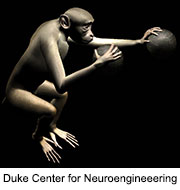
WEDNESDAY, Nov. 6 (HealthDay News) — Scientists report they’ve taught monkeys to control the virtual movements of two arms on a computer screen using only their brains.
The technology, a futuristic melding of mind and machine, is being developed to help paralyzed patients regain some of their independence.
Prior studies have shown that people who are paralyzed from the neck down can learn to control a single robotic arm with the help of electrodes implanted in their motor cortex — the part of the brain that controls movement.
However, the new study marks the first time researchers have been able to design a system that can read the complex array of brain impulses required to move two arms at the same time.
Dual arm movements are necessary for a host of everyday tasks, from typing on a keyboard to tying shoelaces.
Experts who weren’t involved in the study caution that many things still need to be refined before such a system could work in humans. But they praised the work as a significant advance.
“It will be something that could dramatically improve quality of life for people with quadriplegia,” said Michael Goldfarb, a mechanical engineer at Vanderbilt University, in Nashville, who develops robotic prosthetics.
For the study, researchers at Duke University first recorded the brain activity of two rhesus monkeys as they used a joystick to make virtual arms move on a computer screen. They then programmed computers to recognize specific patterns of brain waves that corresponded to those movements.
To read the movements of both arms at once, researchers had to record the impulses of 500 neurons in each monkey’s brain, more brain activity than had ever been used to control virtual limbs.
The monkeys were eventually able to learn how to control the virtual arms while their own arms were restrained and covered so they couldn’t see them while they practiced their task, which involved holding the avatar arms over targets on a computer screen.
Beyond the accomplishment of moving both arms at the same time, researchers say the experiment taught them something important about how the brain works. It seems that the brain uses an entirely different set of signals to coordinate the movement of two limbs than it does to move one limb at a time.
The study was published online Nov. 6 in a special issue of Science Translational Medicine, which was dedicated to brain and machine interfaces.
That’s not the only good news on the horizon.
In a related study in the same issue, researchers in the U.K. and Switzerland report using a brain-machine interface to restore bladder control to paralyzed rats.
With further study, they think the technology could be modified to help people who’ve suffered from spinal cord injuries regain control of their bladder.
Experts praised the discoveries as important, but said much more study is needed before the technology can be put to practical use.
“Doing this right is a matter of getting a lot of little things right,” said Goldfarb. Some of the kinks that still need to be worked out include the quality of the programs that decode the brain signals, and how stable the implants are in the body. “After a few weeks, you can’t read the signals as well any more if scar tissue forms,” he explained.
But he believes there’s a lot of promise in the idea.
“I think the marriage of these two things will be great. It will be a great service,” said Goldfarb. “It’s just not quite ready yet.”
More information
For more on the ways brains and machines can interface, visit the U.S. National Institutes of Health .
Copyright © 2025 HealthDay. All rights reserved.

